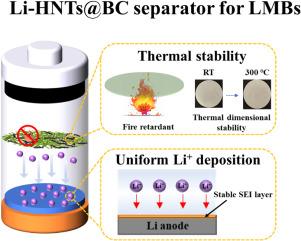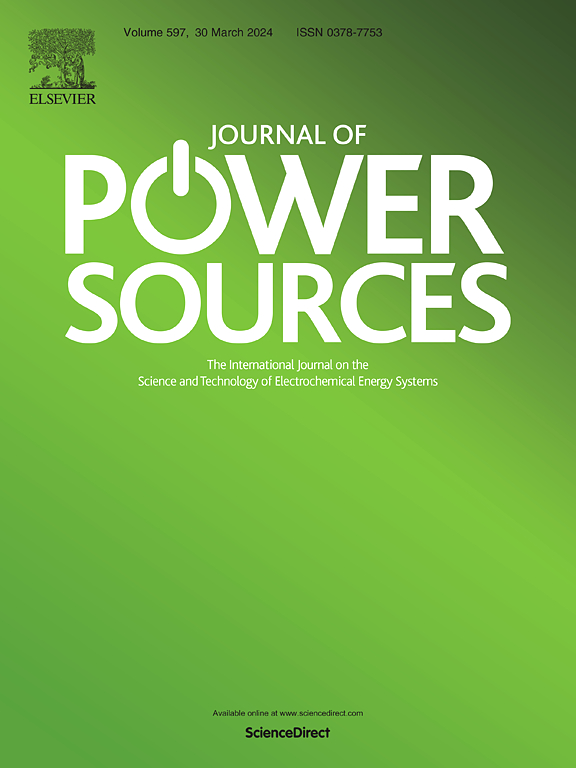用于锂离子电池的具有高安全性和离子传输调节功能的多功能隔膜
IF 7.9
2区 工程技术
Q1 CHEMISTRY, PHYSICAL
引用次数: 0
摘要
常用的聚烯烃隔膜存在电解质浸润性差、热收缩和严重的枝晶生长等问题,严重阻碍了锂离子电池(LIB)的进一步应用和能量密度的提高。因此,设计和制造具有良好润湿性、坚固机械强度和满足耐火耐热安全性的先进隔膜材料对于下一代锂离子电池至关重要。本研究设计并通过真空辅助策略制备了由细菌纤维素(BC)和预层化的海泡石纳米管(Li-HNTs)组成的新型分离器,称为 Li-HNTs@BC 分离器。与传统的 Celgard 分离器相比,所制备的 Li-HNTs@BC 分离器具有良好的热稳定性、高孔隙率(62.99%)和电解质吸收率(497%),以及优异的热尺寸稳定性(在 300 °C 下 30 分钟几乎无收缩)。此外,锂-HNT 还能提供额外的锂离子源并加速锂离子迁移,从而减少电池循环过程中的浓度极化和锂沉积不均。因此,使用 Li-HNTs@BC 隔膜组装的锂//LiFePO4 电池明显提高了充放电可逆性和卓越的速率能力。更重要的是,该隔膜赋予了电池极佳的热安全性,在 150 ℃ 下也能很好地进行处理。本文章由计算机程序翻译,如有差异,请以英文原文为准。

Multifunctional separators with high safety and regulated ion transport for lithium-ion batteries
Poor electrolyte wettability, nasty heat shrinkage and severe dendrite-growth issues of commonly used polyolefin separators significantly hamper further application and improvement of energy-density for lithium-ion batteries (LIBs). Hence, designing and constructing advanced separator materials with good wettability, robust mechanical strength and satisfied fire-thermal safety is critical for next-generation LIBs. In this study, novel separators consisted of bacterial cellulose (BC) and the prelithiated halloysite nanotubes (Li-HNTs), denoted Li-HNTs@BC separator, are designed and prepared via vacuum-assisted strategy. Compared with conventional Celgard separator, the obtained Li-HNTs@BC separators deliver good thermal stability, high porosity (62.99 %) and electrolyte uptake (497 %), and excellent thermal dimensional stability (almost no shrinkage at 300 °C for 30 min). In addition, Li-HNTs could provide extra lithium ions source and expedite lithium ion's migration, thus decreasing the concentration polarization and uneven lithium deposition during the battery cycling. As a result, the assembled Li//LiFePO4 cell using Li-HNTs@BC separator displays obviously improved charging-discharging reversibility and excellent rate capability. More importantly, the separator endows the battery with excellent thermal safety, which could also well-process at 150 °C.
求助全文
通过发布文献求助,成功后即可免费获取论文全文。
去求助
来源期刊

Journal of Power Sources
工程技术-电化学
CiteScore
16.40
自引率
6.50%
发文量
1249
审稿时长
36 days
期刊介绍:
The Journal of Power Sources is a publication catering to researchers and technologists interested in various aspects of the science, technology, and applications of electrochemical power sources. It covers original research and reviews on primary and secondary batteries, fuel cells, supercapacitors, and photo-electrochemical cells.
Topics considered include the research, development and applications of nanomaterials and novel componentry for these devices. Examples of applications of these electrochemical power sources include:
• Portable electronics
• Electric and Hybrid Electric Vehicles
• Uninterruptible Power Supply (UPS) systems
• Storage of renewable energy
• Satellites and deep space probes
• Boats and ships, drones and aircrafts
• Wearable energy storage systems
 求助内容:
求助内容: 应助结果提醒方式:
应助结果提醒方式:


